- Home
- Terry Pratchett
The Folklore of Discworld Page 2
The Folklore of Discworld Read online
Page 2
So now, there’s a drum-roll, the curtains part, and you can watch how the conjurer works …
Chapter 1
THE COSMOS:
GODS, DEMONS
and THINGS
VERY VAST IS THE EXPANDING rubber sheet of the space-time continuum. Should we not call it infinite?
No, as a matter of fact, we should not, not unless we want to get into an interminable argument with both physicists and philosophers – the kind of argument where people steeple their fingers and say, very slowly, ‘We-ell, it all depends on what you mean by “infinite”.’ And go on saying it, with variations, till the beer runs out. If you are very unlucky, they will explain how infinities come in different sizes.
What we can fairly safely say is that there are clumps of matter on that rubber sheet, moving about and organizing themselves into complicated systems. Billions of them. Two of these deserve our close attention. One consists of a rather lumpy and intensely hot spherical core of iron and rock, much of it in a molten state, held together by its own pressure, and wrapped in a thin solid crust. It is whirled through space by the force of gravity. This is the Earth, which is round-like-a-ball. The other is round-like-a-plate, and is moved at a more sedate pace by a team of elephants and a turtle. This is the Discworld.
What they have in common is that each carries through the cosmos a cargo of conscious, imaginative – we could even say, charitably, intelligent – living species. Over the many centuries of their existence, these species have generated an accumulation of thoughts, information, emotions, beliefs and imaginings which envelops their world like a mental atmosphere, a noosphere. Within this noosphere patterns have formed, driven by the irresistible force of narrativium, the narrative imperative, the power of story. Some scholars call the patterns motifs, others topoi, others memes. The point is, they’re there, everyone knows them, and they go on and on. More remarkably, some of the strongest can replicate themselves and go drifting off across the multiverse as particles of inspiration, which leads to some truly amazing similarities between the Earth and Discworld.
THE ELEPHANTS AND THE TURTLE
The absolutely central, incontrovertible fact about the Discworld is that it is a disc. At least, it’s incontrovertible unless you adhere to the Omnian religion, in which case you must controvert it like billy-o. This disc rests upon four gigantic elephants (named Berilia, Tubul, Great T’Phon and Jerakeen), whose bones are living iron, and whose nerves are living gold. These elephants themselves stand upon the shell of the Great A’Tuin, a ten-thousand-mile-long star turtle, which is swimming through space in a purposeful manner. What this purpose may be, is unknown.
A child once asked, ‘Why does the Turtle swim?’
A wise man replied, ‘Child, there is no Why. IT … IS … SO.’
And that could be said of many things.
On Earth ‘everyone knows’ that people used to believe that their planet was also flat, if they thought about it at all. In fact for several thousand years a growing number of educated people have shared the knowledge that it is a globe. Generally speaking it was wisest not to shout about it in the street, though, because of the unrest this could cause. No doubt scholars in the ancient Hindu India partook of this knowledge, but since truth comes in many forms, the age-old epic poems of India declare the world to be a disc.
Further details of Hindu cosmology vary. According to one myth, there are four (or eight) great elephants named the diggaja or digaja, ‘elephants of the directions’, guarding the four (or eight) compass points of this disc, with a type of god called a lokapala riding on the back of each one. But the oldest texts do not claim that they carry the world. According to another myth, however, the world rests on the back of a single elephant, Maha-Padma, and he is standing on a tortoise named Chukwa. Finally, it is said in yet another myth that the god Vishnu once took on the form of a vast tortoise or turtle (krma), so huge that Mount Meru, the sacred central mountain of the world, could rest on his back and be used as a stick to churn the ocean. At some stage, though nobody knows just when, these insights began to blend, with the result that some (but not all) Hindu mythographers now say the world is a disc supported by four elephants supported by a turtle.
Variations of the myth spread out from India to other areas of the globe.1 One that has proved particularly popular involves an infinite regression of turtles. It is said that an arrogant Englishman once mocked a Hindu by asking what the turtle stood on; untroubled, the Hindu calmly replied, ‘Ah, Sahib, after that it’s turtles all the way down.’2 Another variation, briefly mentioned in the film A Thief of Baghdad, involves different creatures but is of value because it adds one vital factor, that of movement. It tells how the world rests on seven pillars, carried on the shoulders of a huge genie, who stands on an eagle, which perches on a bull, which stands on a fish – and this fish swims through the seas of eternity.
Chinese mythology also knows of an immense cosmic turtle, but with a difference. According to the Chinese, our world is not balanced upon the creature’s back (with or without elephants), but is sloshing about inside it. Its plastron contains the oceans upon which all our continents are floating, and when we look up at the dome of the night sky we are seeing the inside of its vast carapace, studded with innumerable stars.
Clearly, fragments of information have drifted through the multiverse and taken root here and there. But the full and glorious Truth is known only on the Discworld. The Turtle Moves!
And beyond that Truth lies an even deeper mystery, one hinted at in the legends of the dwarfs – the legend of the Fifth Elephant. For the dwarfs of Uberwald say there was once a fifth elephant supporting the Disc, but it crashed:
They say that the fifth elephant came screaming and trumpeting through the atmosphere of the young world all those years ago and landed hard enough to split continents and raise mountains. [The Fifth Elephant]
Nobody actually saw or heard this, but the dwarfs say that the vast deposits of iron ore, gold and fat under their mountains are all that remains of the Fifth Elephant. Also that the crash buried thousands of acres of prehistoric sugar cane, creating a mass of dense crystalline sugar which can now be mined. These raw materials form the basis for a flourishing trade in confectionery and in very fine-quality candles, soaps and lamp-oils.
The iron, the gold and the fat undoubtedly exist. Yet the legend itself poses great problems. If the Four Elephants mark the four quarters, where did the Fifth stand? Centrally, to form the pattern known as a quincunx? If it slipped and fell from the Turtle’s back, how could it strike the Disc – did it fall upwards? And if so, wouldn’t it strike the underside of the Disc rather than crashing down through the atmosphere? Did it perhaps briefly go into orbit? Dwarfs are a secretive race, so we are unlikely ever to learn the truth of this.
Some philosophers in Ephebe, hearing the tale, have concluded that the Fifth Elephant is not a gross material being subject to normal physical laws, but the pure, subtle, ethereal Quintessence of Cosmic Pachydermacy. It is nowhere to be seen because it is present everywhere. Without it, the whole Universe of the Discworld would cease to exist. By a remarkable coincidence, this is exactly how the Earth philosophers of Ancient Greece described their hypothetical Fifth Element – the invisible, impalpable, ethereal Quintessence which provides the essential counterbalance to the four material elements of Earth, Air, Fire and Water, the five together making up their universe. Or it may just be a legend. Legends don’t have to make sense. They just have to be beautiful. Or at least interesting.
THE GODS
At the last count, the number of major gods known to research theologians on the Discworld was 3,000, and rising. The potential number is unlimited, since at any moment a new one may be called into existence by the mere fact that it has occurred to a human being (or to a member of any other sentient species) to believe he, she or it exists, and to feel an urge to worship him, her or it. The greater the number of devotees, rituals, shrines, temples, sacrifices, and sacred book
s which develop from this initial urge, the greater the status of the deity. Conversely, of course, since belief is the life-force and nourishment of gods, in the course of time particular gods can and do lose power as the number of their believers drops. Rarely, however, do they dwindle into total insignificance, and any good dramatic miracle quickly restores them to their previous status, as was proved by the events narrated in Small Gods. Two of them, Fate and Luck (The Lady), are almost certainly immune to change – they don’t have temples, but there can hardly be anybody, anywhere in the multiverse, who does not believe in them. In addition, dwarfs have formulated the notion of a Creator quite distinct from any individual gods, whom they call Tak; we shall have more to say on this in the next chapter.
Discworld people vary considerably in their attitude to the gods. Certain groups, notably witches, wizards, policemen and dwarfs, ignore them. Not that anybody would actually deny that they exist – it is known that they are quick with a thunderbolt if they detect actual atheism – but it is perfectly possible to get on with one’s life without thinking about them. Similarly, the citizens of Ephebe do not pay very much attention to their numerous divinities. On the other hand, the land of Djelibeybi is swarming with local gods, in whose honour devoted priests carry out an endless round of sacred rituals. In Omnia and Borogravia, every aspect of life is dominated by the very demanding cult of a single god, Om and Nuggan respectively. As for Ankh-Morpork, it is rather a paradox. Street after street has a temple in it, enough of them to suit every ethnic group, yet nobody could call it a pious city, exactly. The citizens seem willing to worship any god at all, provided he or she is good for trade. In that city, we learn (in Making Money), there is even a god-of-the-month club. And a deity currently in the ascendant is Anoia, goddess of Things That Get Stuck in Drawers. That’s life in the big city for you. People will take a chance on heaven, but they would like to get their hands on the corkscrew right now, amen.
The major gods, loosely organized into a rather grumpy pantheon, have chosen to make their home on the peak of a truly remarkable mountain, Cori Celesti – a spire of rock and ice, ten miles high, rising above the clouds at the very centre and hub of the Disc. The home itself is of course a vast marble palace, a pile of pillars, pilasters, pinnacles, pyramids, parapets, peristyles, porticos, porches, portals and pavilions, which they have decided to call Dunmanifestin. Gods are not noted for good taste or a sense of the ridiculous, nor indeed, in most cases, for intelligence.
If the gods have the ability to look into other dimensions, then they will see some remarkable resemblances to themselves in the cosmic soap operas of Earth. One thing they have apparently taken notice of is fashions in divine accessories and lifestyles – thunderbolts, goat’s feet, a jackal’s head, and so on – whatever. If Zeus and his gang have a Mount Olympus, and Vishnu and his gang have a Mount Meru, they get themselves their Cori Celesti, and it’s higher than the other two put together. This passion for keeping up with the Zeuses means that anyone with a working knowledge of inter-dimensional mythology who drops in at Dunmanifestin will feel quite at home there.
The Disc gods will have noticed, too, that all pantheons pass their time in banqueting, and that many also like playing board games. For example, one of the first things the Norse gods did when they had finished creating the cosmos was to settle down for a happy session of hnefatafl, played with pieces made of pure gold. As hnefi is ‘fist’ and tafl is ‘table’ or ‘board’, the name means roughly ‘The Punch-up Board-Game’; it is a bit like draughts but much more like the Discworld game of Thud. It is thought that the run of play determines the destinies of men, gods, giants and the world itself. Apparently the game will be disrupted and the pieces scattered when gods and monsters fight at Ragnarok, the War at the End of the World, also known as the Doom of the Gods and the Twilight of the Gods. Afterwards, according to the Old Icelandic prophetic poem Völuspá, a new world will arise and the surviving younger generation of gods will restore both the cosmic order and the game which expressed it:
Then once again in the grass are found
Draughtsmen all of gold,
The wondrous draughtsmen the gods had owned
In the earliest days of old.
On Earth, however, not everyone relishes the idea of being a pawn in a game played by gods. The twelfth-century Persian poet Omar Khayyám made a resigned but gloomy comment on life in his Rubâíyát:
’Tis all a Chequer-board of Nights and Days
Where Destiny with Men for Pieces plays:
Hither and thither moves, and mates, and slays,
And one by one back in the Closet lays.
The gods of the Discworld lack the patience and imagination to play chess, draughts, hnefatafl, or even chequers; their idea of amusement is a form of Snakes and Ladders (played with greased rungs), accompanied by heavy betting and a good deal of bluffing and cheating, which brings it nearer to poker. The currency staked is the souls of men. The gaming board is a finely carved map of the Disc, overprinted with squares. Occasionally, the playing pieces represent monsters; more often, they are beautifully detailed models of those human beings who have foolishly done something to get themselves noticed. It is said that these unfortunate mortals sometimes faintly hear, as they hasten to their doom, the rattle of dice in the celestial (skull-shaped) shaker.
This is one of the reasons it’s wise to steer clear of the gods, as the wizard Rincewind knows:
‘I don’t like the idea of going anywhere near the gods. We’re
like toys to them, you know. And they don’t realize how easily
the arms and legs come off.’ [The Last Hero]
Or maybe (and even Rincewind in his darkest moments didn’t think of this) they do realize, and find it funny. That at any rate is what Will Shakespeare thought when he wrote King Lear, in one of his darkest moments:
As flies to wanton boys are we to the gods;
They kill us for their sport.
The gods have an age-old feud with the Ice Giants, a species of super-troll the size of large houses, craggy and faceted, and composed entirely of ice which glints green and blue in the light – apart from their small, deep-sunken, coal-black eyes. Just as Zeus and the Olympians defeated the gigantic Titans and imprisoned them inside volcanoes such as Etna (where they still wriggle about, causing eruptions and earthquakes), so Blind Io and the other Discworld gods defeated the Ice Giants and imprisoned them under the eternal ice at the Hub. There is, however, a prophecy. A very Norse-sounding prophecy, a prophecy of End Time doom:
At the end of the world they’ll break free at last, and ride out on their dreadful glaciers and regain their ancient domination, crushing out the flames of civilization until the world lies naked and frozen under the terrible cold stars until Time itself freezes over. Or something like that, apparently. [Sourcery]
Whether it comes with ice ages, global warming, a nasty bang or a little whimper, the end of a world is never much fun.
Blind Io
Io is the chief of the gods. He is elderly, white-haired and white-bearded, dressed in a toga and wearing a white blindfold which conceals the blank skin where his eyes should be. Despite this, and despite his name, he sees everything that is going on, since in fact he has a number of detached eyes (several dozen of them) which hover around him and keep a sharp look-out in all directions. His throne too is encrusted with eyes. He is the Supreme Thunderer, having absorbed every other thunder-god on the Disc into himself. However, he keeps a stock of seventy hammers, double-headed axes, and thunderbolts, each of a different design, to blend in with local expectations wherever he may appear. This avoids unnecessary distress to worshippers.
At one time he employed a pair of ravens to fly hither and yon and keep him informed of everything going on in the world. In another universe Odin, chief of the Norse gods, had had exactly the same idea; his two ravens were named Memory and Thought. From the god’s point of view, it’s a good plan, efficient and energy-saving. From the ravens’ poin
t of view, regrettably, Io’s free-floating eyeballs were altogether too much of a temptation (Odin’s one eye is firmly fixed in his head, so in his case the problem did not arise) and after some embarrassing scenes Io’s ravens had to be dismissed.3
Earth is well stocked with thunder-gods, including Zeus, Jupiter, Thor, Perkun, Indra and Jehovah. Usually, a thunder-god is also the ruler of his particular pantheon, but Thor is an exception, taking second place to Odin (god of war, magic, death and poetry). Blind Io’s insistence on being the Disc’s only Thunderer is an example of how Discworld gods love to outdo those of Earth in displays of status. It’s the same with his lavish use of detached eyeballs, whereas on the Earth even the mightiest deities are satisfied with only one. These are mostly to be found in Ancient Egypt, where the Eye of a major god such as Ra, Atum, or Horus embodied the concentration of his divine power and could be sent out to act on his behalf. The separated Eye, called the wedjat, was often shown in religious art, and worn as an amulet. It was sometimes identified with the sun or the moon, and sometimes personified as itself a goddess. That’s something Io has not yet thought of.
Dagon
A very ancient, mysterious and probably unpleasant god, believed to have been once worshipped on the mud-flats where the city of Ankh-Morpork was later built. At least, something happened not so long ago when the late Mr Hong opened a takeaway fish bar on the site of an old temple in Dagon Street, at the time of the full moon – or, some say, of a lunar eclipse. Everybody has heard about it, in general terms, but nobody says just what it was …
Traditions of the Earth are fuller. It appears that Dagon was first worshipped there some four thousand years ago by Philistines and Phoenicians in the Middle East; there were temples to him in Gaza and other coastal towns. According to the Bible (1 Samuel 5), his statue stood in a mighty temple at Ashdod, but when the captured Jewish Ark was brought into this temple the statue crashed to the ground and its head and hands broke off, leaving only a stump on the threshold.

 Feet of Clay
Feet of Clay The Color of Magic
The Color of Magic Thud!
Thud! Good Omens: The Nice and Accurate Prophecies of Agnes Nutter, Witch
Good Omens: The Nice and Accurate Prophecies of Agnes Nutter, Witch I Shall Wear Midnight
I Shall Wear Midnight Mort
Mort Raising Steam
Raising Steam Guards! Guards!
Guards! Guards!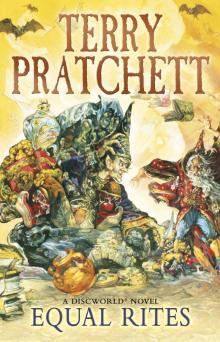 Equal Rites
Equal Rites A Hat Full of Sky
A Hat Full of Sky The Light Fantastic
The Light Fantastic Mrs Bradshaw's Handbook
Mrs Bradshaw's Handbook Wyrd Sisters
Wyrd Sisters Soul Music
Soul Music Small Gods
Small Gods Sourcery
Sourcery Reaper Man
Reaper Man Night Watch
Night Watch Lords and Ladies
Lords and Ladies The Fifth Elephant
The Fifth Elephant Monstrous Regiment
Monstrous Regiment The Truth
The Truth Witches Abroad
Witches Abroad Eric
Eric Going Postal
Going Postal Men at Arms
Men at Arms Jingo
Jingo The Amazing Maurice and His Educated Rodents
The Amazing Maurice and His Educated Rodents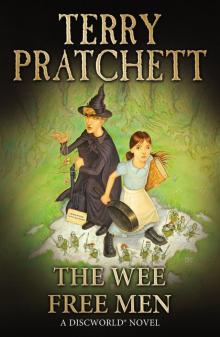 The Wee Free Men
The Wee Free Men Pyramids
Pyramids Wintersmith
Wintersmith Moving Pictures
Moving Pictures Carpe Jugulum
Carpe Jugulum Interesting Times
Interesting Times Maskerade
Maskerade Making Money
Making Money The Shepherd's Crown
The Shepherd's Crown Hogfather
Hogfather Troll Bridge
Troll Bridge The Last Continent
The Last Continent The Sea and Little Fishes
The Sea and Little Fishes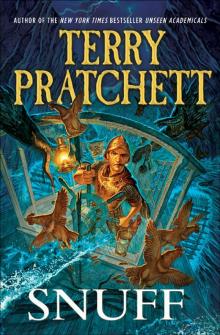 Snuff
Snuff Unseen Academicals
Unseen Academicals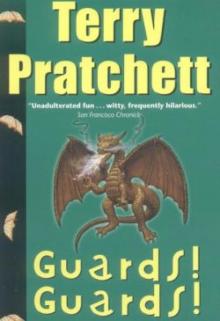 Guards! Guards! tds-8
Guards! Guards! tds-8 Jingo d-21
Jingo d-21 Turtle Recall: The Discworld Companion ... So Far
Turtle Recall: The Discworld Companion ... So Far The Fifth Elephant d-24
The Fifth Elephant d-24 Discworld 39 - Snuff
Discworld 39 - Snuff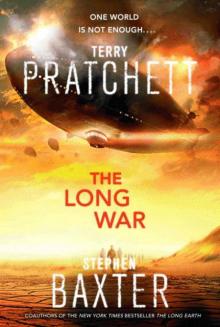 The Long War
The Long War Only You Can Save Mankind
Only You Can Save Mankind The Science of Discworld III - Darwin's Watch tsod-3
The Science of Discworld III - Darwin's Watch tsod-3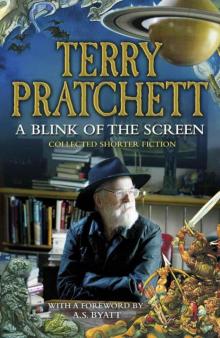 A Blink of the Screen: Collected Short Fiction
A Blink of the Screen: Collected Short Fiction Unseen Academicals d-37
Unseen Academicals d-37 Wings
Wings Making Money d-36
Making Money d-36 A Blink of the Screen
A Blink of the Screen Johnny and the Bomb
Johnny and the Bomb Dodger
Dodger Strata
Strata Discworld 02 - The Light Fantastic
Discworld 02 - The Light Fantastic The Folklore of Discworld
The Folklore of Discworld The Science of Discworld
The Science of Discworld The Unadulterated Cat
The Unadulterated Cat Raising Steam: (Discworld novel 40) (Discworld Novels)
Raising Steam: (Discworld novel 40) (Discworld Novels) The World of Poo
The World of Poo Discworld 05 - Sourcery
Discworld 05 - Sourcery The Witch's Vacuum Cleaner: And Other Stories
The Witch's Vacuum Cleaner: And Other Stories The Science of Discworld II - The Globe tsod-2
The Science of Discworld II - The Globe tsod-2 Small Gods: Discworld Novel, A
Small Gods: Discworld Novel, A Men at Arms tds-15
Men at Arms tds-15 Tama Princes of Mercury
Tama Princes of Mercury The Last Hero (the discworld series)
The Last Hero (the discworld series) The Long Utopia
The Long Utopia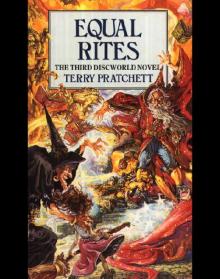 Discworld 03 - Equal Rites
Discworld 03 - Equal Rites Terry Pratchett - The Science of Discworld
Terry Pratchett - The Science of Discworld The Long Earth
The Long Earth The Carpet People
The Carpet People The Sea and Little Fishes (discworld)
The Sea and Little Fishes (discworld)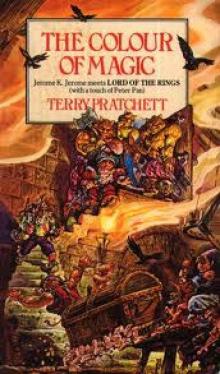 The Colour of Magic
The Colour of Magic Discworld 16 - Soul Music
Discworld 16 - Soul Music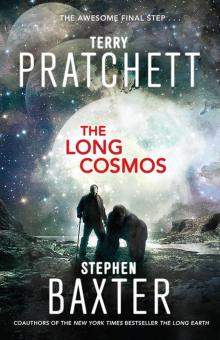 The Long Cosmos
The Long Cosmos The Dark Side of the Sun
The Dark Side of the Sun Monstrous Regiment tds-28
Monstrous Regiment tds-28 The Bromeliad 3 - Wings
The Bromeliad 3 - Wings Dragons at Crumbling Castle: And Other Stories
Dragons at Crumbling Castle: And Other Stories Night Watch tds-27
Night Watch tds-27 The Science of Discworld I tsod-1
The Science of Discworld I tsod-1 The Bromeliad 1 - Truckers
The Bromeliad 1 - Truckers The Science of Discworld Revised Edition
The Science of Discworld Revised Edition The Abominable Snowman
The Abominable Snowman Father Christmas’s Fake Beard
Father Christmas’s Fake Beard The Bromeliad Trilogy
The Bromeliad Trilogy A Slip of the Keyboard
A Slip of the Keyboard The Wee Free Men d(-2
The Wee Free Men d(-2 Johnny and the Dead
Johnny and the Dead Mrs Bradshaw's Handbook (Discworld Novels)
Mrs Bradshaw's Handbook (Discworld Novels) Truckers
Truckers The Amazing Maurice and His Educated Rodents d(-1
The Amazing Maurice and His Educated Rodents d(-1 Diggers
Diggers Thief of Time tds-26
Thief of Time tds-26 Science of Discworld III
Science of Discworld III Dragons at Crumbling Castle
Dragons at Crumbling Castle Nation
Nation Darwin's Watch
Darwin's Watch Interesting Times d-17
Interesting Times d-17 The Bromeliad 2 - Diggers
The Bromeliad 2 - Diggers The Science of Discworld II
The Science of Discworld II